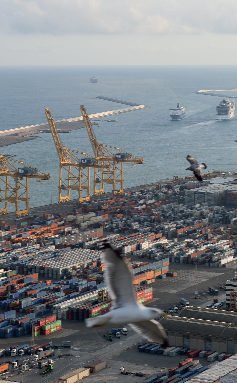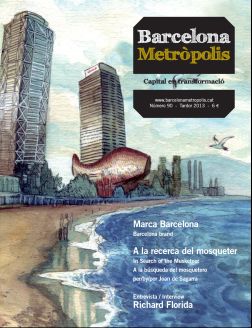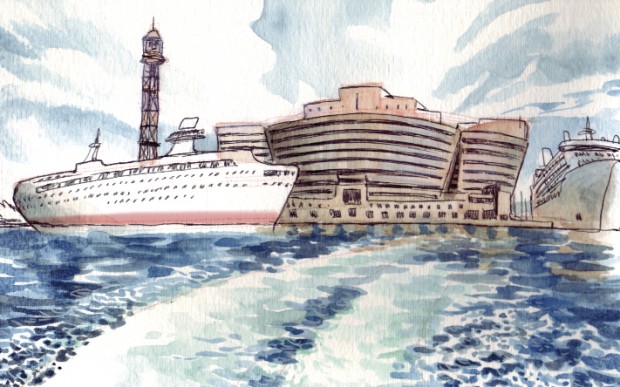The aim is to consolidate Barcelona as a leading city in Europe. Bringing the project to fruition involves four requirements: a hinterland with a strong economy, communications with the world, the creation of science and technology and an attractive place to live in. How well is Barcelona doing in each one?
“If we get up early, and when I say early I mean very, very early […], we are an unstoppable country.” Josep Guardiola, 8 September 2011
In our childhood, the image of a modern and dynamic city was epitomised by the American downtown. However, when it actually became possible to build skyscrapers, Barcelona resisted the urge to fill itself with them. Why? Because the locals detested the idea of a neighbourhood that became deserted once evening fell. They sought an equilibrium through the scattering of office areas: “unique” buildings, small clusters in the upper part of Avinguda de Diagonal, on Carrer de Tarragona, and later Diagonal Mar… so that not only would they not put paid to life in the neighbourhoods but would create jobs, giving a new lease of life to the traditional fabric – houses, shops, workshops, the places where people socialise. The result was an attractive city to live and work in.
However, despite this conservative city planning, the idea is to consolidate Barcelona as a leading city in Europe. Bringing the project to fruition involves four requirements: a hinterland with a strong economy, communications with the world, the creation of science and technology and an attractive place to live in. How well is Barcelona doing in each one?
Fortunately, major segments of the Catalan industry – automotive, food, chemical – are still holding out, albeit in a scenario of slow decline: even in terms of the Spanish average, Catalonia is an economy in the process of deindustrialisation. Furthermore, although the port has continued to expand and can leverage the fact that the main sea route now passes through the Mediterranean, it has been impossible to overcome the lethargy of the Spanish State with regard to improving connections with the rest of the world. The city has chosen to put the areas surrounding the port to unrelated uses (a prison, an audiovisual city, an Olympic Village), compromising the possibility of developing economic activity (logistics and manufacturing) directly linked to maritime traffic there. I fear that in this case the objective of creating balanced districts is a mistake, because the port has a great future, but it needs room to breathe.
On the other hand, Barcelona has made a decided commitment to promoting tourism, the beginning of which is associated with the Olympic Games, which unveiled the city to the world in a favourable light: a Mediterranean city that was capable of hosting Games that were both innovative and efficient. The city went on to recover its ability to organise major trade fairs and congresses thanks to infrastructure improvements – the Palau de Congressos de Catalunya, the International Conventions Center of Barcelona, Fira de Barcelona-Gran Via – and, thanks to the dogged efforts of Barcelona City Mayor Pasqual Maragall, at loggerheads with the hotel lobby for this same reason, new hotels. Meanwhile, the port has also made a considerable effort to position itself as a cruise stop-over point.
This initiative has been enormously successful, and Barcelona has become a tourist destination that excels in the professional, cruise, urban and low-cost segments. Among other things, this has been possible because the airport is equipped with a large terminal and a new runway that, while short, is suitable for the majority of incoming flights, allowing it to absorb the tremendous growth of air-traffic generated by the explosion of tourism and still have plenty of capacity to spare. Furthermore, business tourism and cruises have stimulated the slow but steady opening of transcontinental routes that are essential to the city’s competitiveness.
However, progress on the third front, that of “knowledge”, has been more limited. An entire neighbourhood was reclassified as “@22” to specialise in economic activities related to ICT technologies and multimedia. The results have been positive but modest, and at least partly threatened by the desertion of the Telecommunications Market Commission.
However, in this field, Barcelona has benefited from the fact that for fifteen years now the government has made a major effort to develop a scientific pole with its greatest density in the city. Thanks to this, apart from university research teams and large hospitals, Barcelona has some thirty first-class research centres (for genomics, photonics, biotechnology, etc.). One piece of data should suffice to illustrate the magnitude of the commitment: for every researcher that Spain has in Catalonia (in the Spanish National Research Council), the Government of Catalonia (in its equivalent organisation, the CERCA Institute) has four.
Another piece of information demonstrates that the system’s productivity is impressive: per million inhabitants, the fiercely disputed resources captured by Catalan researchers from the European Research Council are only outdone by those captured by Switzerland, Israel, the Netherlands and Sweden. Currently, the Government of Catalonia is spearheading the implementation of a high-level engineering training project.

© Albert Armengol
The port has continued to expand, benefiting from the fact that the main route by sea now runs through the Mediterranean, but has been unable to overcome the neglect of the Spanish State in terms of improving its connections beyond. In the image, the container terminal view from the top of Montjuïc.
It is uncertain whether the government can maintain its commitment to science and technology in the current context of a distressing financial crisis, but whether or not it does so will be the most important factor in determining Barcelona’s strength and prosperity.
Finally, there is the question of quality of life, so zealously safeguarded by the city-planning authorities and the population. The promises not to build new fast roads were forgotten, and forgiven, in the preparation for the 1992 Olympics, which involved the execution of all Porciol’s projects, but also the impressive opening up of the city to the sea. Today, Barcelona is seen as a city with a high quality of life and this, nowadays, is its main hook in attracting investments. However, this quality is threatened by the conversion of several neighbourhoods into theme parks whose sole purpose in life is to serve tourism. Furthermore, a very important part of tourism in Barcelona is that which equates Spain with loose working hours, noise and alcohol. Does it make sense that the same city that put up such a die-hard struggle against the dominance of skyscrapers to save a whole neighbourhood from becoming deserted in the evening should now allow entire neighbourhoods to lend themselves to cheap and bothersome diversion?
It is undoubtedly a suicidal attitude, because the quality of life that really matters in attracting economic activity is not that of the low-cost weekend tourist, but rather the executive who is thinking about settling here. The latter, unlike the former, is the early bird that catches the worm.
Barcelona can become a leading city in Europe, although this does not depend on increasing the number of tourists who stay overnight, but rather on its ability to protect quality of life (threatened above all by cheap tourism), the development of economic activity around its port and its commitment to science and technology. Barcelona can do little by itself in the third field, quite a lot in the second and a great deal in the first. I am not sure that everyone fully realises this.




